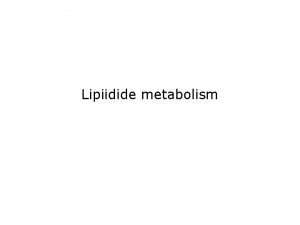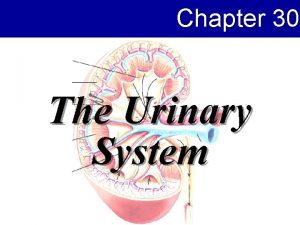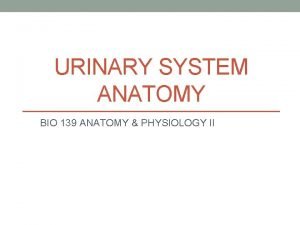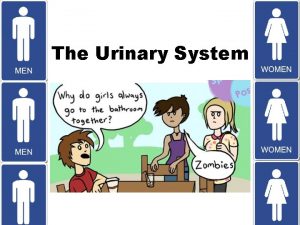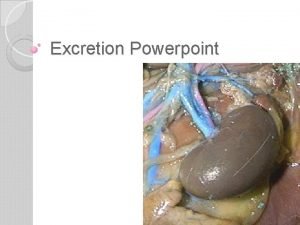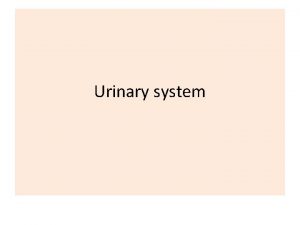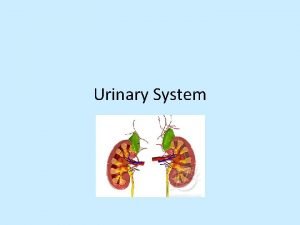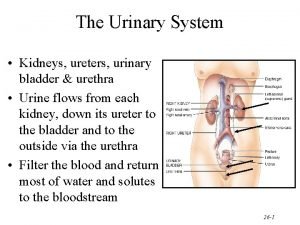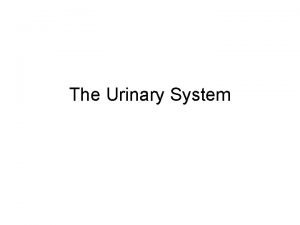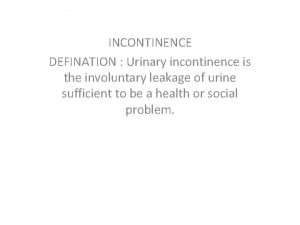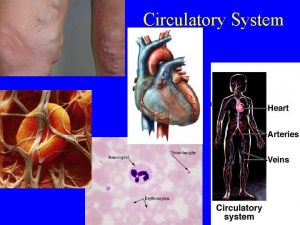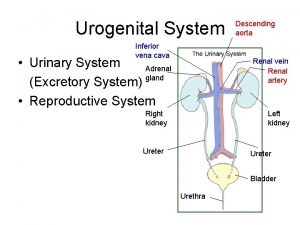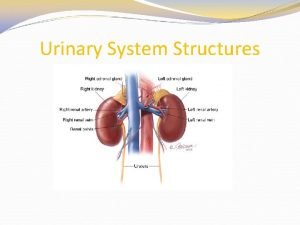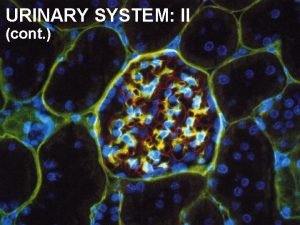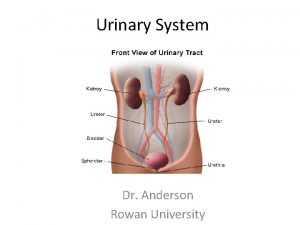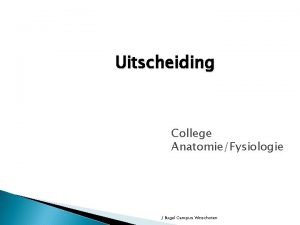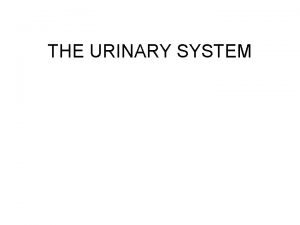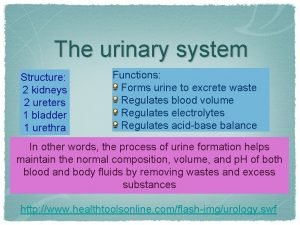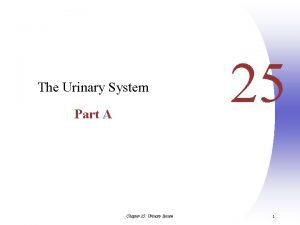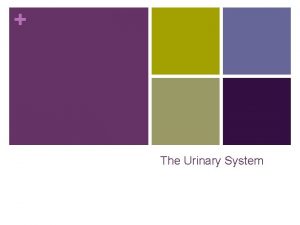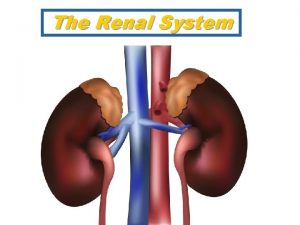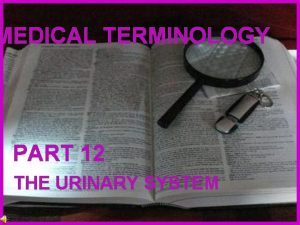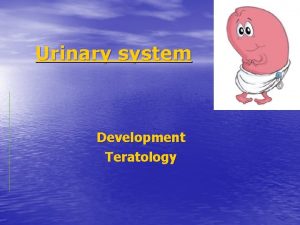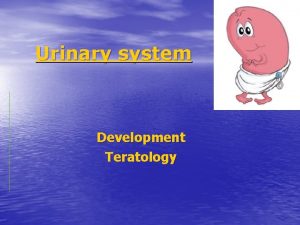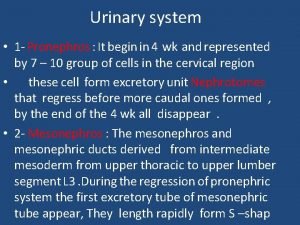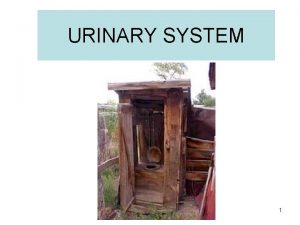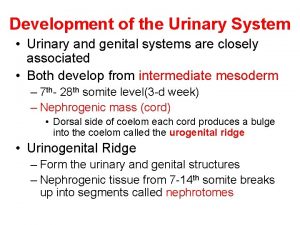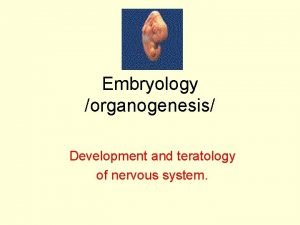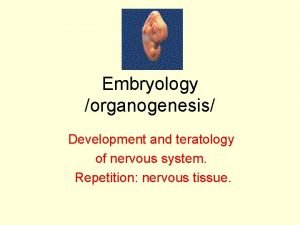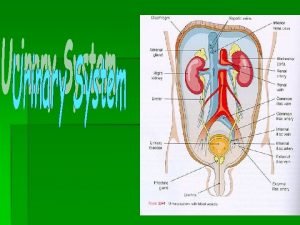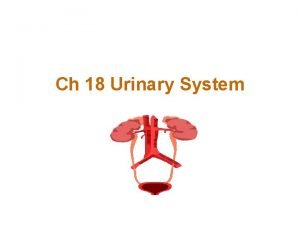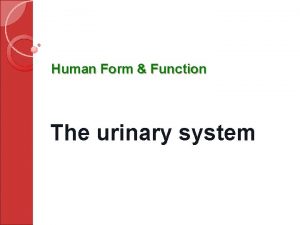Urinary system Development Teratology Intermediary mesoderm Pronephros 3

















































- Slides: 49

Urinary system Development Teratology

Intermediary mesoderm: • Pronephros 3 rd week, C Ductus mesonephricus (Wolffi) • Mesonephros 4 th week, C 6 -L 3 • Metanephros 5 th week, L 4 -S

- paraaxial - intermediary - lateral mesoderm pronephros mesonephros metanephros + ureteric bud





Kidney development

Nephron development glomerulus

Ascensus renis

Cloaca development Sinus urogenitalis: -canalis vesicourethralis -pars pelvina -pars phalica

Cloaca • Septum urorectale – sinus urogenitalis + rectum (cloacal membrane – urogenital m. + anal m. ) • Sinus urogenitalis - canalis vesicourethralis urinary bladder, ♀ uretra - pars pelvina ♂ pars prostatica et diaphragmatica uretrhrae - pars phalica ♂ pars phalica urethrae ♀ vestibulum vaginae ♀ - vestibulum vaginae

Wolffian duct (ductus mesonephricus) and ureteric bud Cloacal epithelium – from ndoderm seminal vesicles prostate Epithelium of trigonum vesicae – from mesoderm

Congenital malformations of urinary system Hypoplasia – small kidney Reflux – Hydronephrosis – urine stasis

Congenital malfromations (CM) • 1. CM of kidney • 2. CM of pelvis and ureter • 3. CM of urinary bladder • 4. CM of urethra

1. CM of kidney • anomalies of number • anomalies of shape • anomalies of postion (ectopia) • anomalies of parenchyma (nephrodysplasia) • anomalies of vessels Kidney malformations arrise at the begining of development (development of metanefros isn‘t induced by ureteric bud or both kidney are closely together – before week 6) or later (during incomplete ascensus renis – after week 8).

Agenesis renis • bilateral (1 : 3000; prenatal dg. – oligohydramnion, hypotrophic fetus, skeleton deformities and lung hypoplasia due to fetus oppresion) - (death by uremia and drespiratory distress) • unilateral (1 : 1500) + agenesis of ipsilateral ureter • and renal vessels; etiology: absence of metanephros, ureteric bud did not develop or did not reach metanephros (regression) – metanephros development was not induced • – genetic disposition

1 – kidnye agenesis 2 – kidnye agenesis + cross ectopia of ureter 1 2

Supernumerary kidney (2 -3 % newborns) Ren duplex • unilateral or bilaterl • + pelvis duplex and partially or completely ureter fissus or ureter duplex • etiology: 2 ureteric buds or branching of one bud in proximal end

1 – ren duplex et ureter duplex, 2 – ureter fissus 1 2

Shape malformations of kidney: Horse-shaped kidney (ren arcuatus) 1: 500 • etiology: fusion of lower pole of both metanephros in front of large vessels (aorta + v. cava inf. ) • fused parenchyma = isthmus „brakes“ ascensus renis bellow detachment of a. mesenterica inf. (+position anomaly - ektopia) and rotation (+ malrotation; hilus – ventrally), ureters run in front of isthmus – + renal vessels duplication

A B A – ren arcuatus B – ren fungiformis C – ren sigmoideus Anomaly of the shape + ektopia: + urine stasis – hydronefrosis vesicaureteric reflux secondary infections C

Position anomalies: Ectopia of kidney uni-, bilat. • - ren pelvicus (ren sacralis, ren lumbalis): retention of kidney during ascensus renis • - cross ectopia: both ureters grow into metanephros on one side or during ascensus renis one kidney transfers on the oposit side and fuse with the other kidney

Ren pelvicus + ren + ureter duplex Cross ectopia

Malrotation (or hyperrotation) of kidney • is connected with ectopia • or anomaly of kidney shape hilus – ventrally (embryonic position) or dorsaly • Notice: (normal adult position of hilus is medial)

Defekts of parenchyma: Polycystic kidneys nephrodysplasia polycystica • diffuse cystic malformation (always bilat. ) – cystic degeneration of kidney • 2 forms of polycystic disease: - autosomally dominant type ˝adult˝ macrocystic form - autosomally recesive type ˝infantil˝ microcystic form

autosomally dominant type APCD – Adult Polycystic Disease • Disease manifests in adulthood (after 30 th); 1: 400 - • 1000, probability of transmission to offspring is 50 %; etiol. : patol. genes on 4 th and 16 th chromosomes – insufficient polycystin production (membrane protein necessary for differentiation of cells in renal tubules). • Klinic manifestation: bilat. enlarged kidney, macroscopic cysts, • abdominal and/or lumbal pain, hematuria, hypertension, infections, renal insufficiency and failure. Dg. : (FA), abdomen palpation, sono event. CT • Th. : symptomatic, decelerate progression of disease, renal failure – renal funcions have to be compensated (hemodialysis, peritoneal dialysis, transplantation)

Polycystic kidney – macroscopic cysts are seen also on the kidney surface

autosomally recesive type IPCD - ˝infantil˝ form • 1 : 40. 000, probability of transmission to offspring - 25 • • % children of healthy parents „disease carriers˝; + anomalies also in liver, spleen, lungs, etiol. : unclear - defect of ureter development (nephrons are not connected with collecting ducts) • Klinic manifestation: bilat. enlarged kidneey, hypertension, decreased glomerular filtration, renal failure. To a lesser extent of damage 50 -80 % children can live about 15 years. Some children die shortly after birth by lung failure. • Prenatal dg. in week 9 of i. u. dev. – FA, DNA markers. • Th. : same as in PCHLAD

Polycystic kidney – cysts are not seen on the surface of kidney

Hypoplasia renis • Insuficiently developed • • kidney – small, small amount of histologically normal and functional nephrons usually unilateral compenzational hypertrofia of the other kidney

A – unilateral renal agenesis B – pelvic ren + ureter bifidus C – kidney malrotation + ren duplex D – crossed ectopia E – „pancake“ kidney F – supernumerary kidney

Wilms‘ tumor (nephroblastom) • The most frequent type of tumors in chidren under 5 years, rare in adulthood • 90% treatment succes, also in case of greater distribution (metastasis) • familiar occurrence – tumor contais cells of mesonephros • etiology: - hereditary basis

Thesaurismosis („storage disease“) A metabolic disorder in which a substance is stored in certain cells of some organs, usually in large amounts, due to defect production of enzymes splitting this substance. It causes functional failure of storing organs Etiol. : defected gen in auto- or heterosomes, usually recessive inheritance • • • Anderson-Fabry disease (storage of cerebrosides = neutral sphingolipids), von Gierke disease (storage of glycogen), Gaucher disease (storage of glukocerebrosides), Fanconi sy. (storage of cystine; cystinóza, cystinurie) Primary hyperoxaluria – cong. defect of glykooxalates production (storage of oxalates; urolithiasis). Cong. defects of metabolism of purines – familiary gouty juvenile nephropathy + artritis already in the 2 nd dacede of life.

Anomalies of renal vascularization • Arise during ascensus renis – accesory arteries from a. iliaca and aorta (there are NOT collaterals between arteries! – obstruction causes infarction of renal parenchyma) • supernumerary veins (with collaterals) • accesory arteries – 25 %, veins - 12, 5 %

Renal renculi

2. CM of pelvis and ureter • Ureter duplex, ureter fissus (+ pelvis duplex, ren duplex) • unilat. or bilat. , partial or completel • etiology: branching or accesory ureteric bud

Ectopic defects of ureter • ectopia of orificium ureteris –ureter opens into urethra, uterus or vagina (rarely into ductus deferens) • cross ectopia of ureter, „retrocava″ ureter –

Congenital stenosis, obstructions, atresis Physiol. ureter narrowings: 1. pelvi-uretral junction, 2. crossing with vasa iliaca, 1 3. pars intramuralis – ureter-vesical junction. 2 3

3. CM of urinary bladder • Extrophia 1 : 40. 000 • (2 -3 ♂ : 1♀) Ventral abdominal wall and ventral wall of urinary bladder are not formed; urinary bladder is opened and inner surface of its dorsal wall is visible (+ epispadia and cleft of symphysis (diastasis)

Extrophia • etiol. : defect of mezenchyme migration • between ectoderm of abdominal wall and cloaca in week 4 Reconstruction of the wall (24 - 48 h after birth), epispadia (about 2 nd year).

Sy. prune – belly • 1 : 40 000 • Trias of syndromes: 1. agenesis of muscles in abdominal wall 2. obstruction of urinary bladder in region of internal obstruction of urinary bladder urethral ostium (dilatation of bladder, megaureters and hydronephrosis – above obstruction) 3. bilateral kryptorchism • Etiol. : unclear hormonal treatment (estrogens) of mother during the 1 st trimestr was frequently find in anamnesis • Prognosis: viability depends on number of functional nephrons at birth.

defect obliteration of ductus allantoideus – • urachal cysts and fistulae (a, b) • urachus patens (c) a b c

4. CM or urethra • Clefts of urethra: Hypospadia insufficient fusion of plicae genitales Epispadia see extrophia

Sources of pictures: • http: //www. embryology. ch/genericpages/moduleorgano en. html embryology. med. unsw. edu. au/. . . /BGDlab. XYXX_5. htm. www. embryology. ch/. . . /genitinterne 06. html. • • • www. emedicine. com/ped/topic 704. htm. • embryology. med. unsw. edu. au/Defect/page 4. htm. • www. childrenskidneydisease. org/Stories. asp.

Vývoj zevního genitálu a uzavření uretry ♂ Zdroje pro vývoj zevního genitálu: Tuberculum genitale Plicae genitales (urethrales) Tori genitales (plicae labioscrotales)

Vývoj nefronu


Močový měchýř, ureter
 Lymphatic system
Lymphatic system Cloacal membrane
Cloacal membrane Bladder mesoderm
Bladder mesoderm Intermediary metabolism
Intermediary metabolism Work based learning intermediary
Work based learning intermediary Intermediary metabolism
Intermediary metabolism Intermediary oriented marketplace
Intermediary oriented marketplace Intermediary devices
Intermediary devices Intermediary/gatekeeper model of communication
Intermediary/gatekeeper model of communication Trusted intermediary
Trusted intermediary Types of financial intermediaries
Types of financial intermediaries Financial intermediary
Financial intermediary Financial intermediary
Financial intermediary Financial intermediary
Financial intermediary Financial intermediary
Financial intermediary Intermediary metabolism
Intermediary metabolism Physiology of urine formation
Physiology of urine formation Glomerular filtration
Glomerular filtration Hyperproteinuria definition
Hyperproteinuria definition Whats gametes
Whats gametes Fetal pig urinary system labeled
Fetal pig urinary system labeled The urinary system chapter 30
The urinary system chapter 30 Chapter 15 the urinary system figure 15-3
Chapter 15 the urinary system figure 15-3 Chapter 20 urinary/excretory system
Chapter 20 urinary/excretory system Urinary system model
Urinary system model Urinary system model
Urinary system model Osteichthyes
Osteichthyes Urinary system powerpoint
Urinary system powerpoint Renal system
Renal system Urinary system pathway
Urinary system pathway Urinary system histology
Urinary system histology Abnormal constituents of urine
Abnormal constituents of urine Spill of dye
Spill of dye Defination of urine
Defination of urine Urinary system label
Urinary system label Rat external anatomy
Rat external anatomy Rat urinary system
Rat urinary system Inferior vena cava urinary system
Inferior vena cava urinary system Figure 15-4 is a diagram of a nephron
Figure 15-4 is a diagram of a nephron Parietal layer bowman's capsule
Parietal layer bowman's capsule Renal tubule
Renal tubule Urinary system
Urinary system Juxtaglomerular apparatus
Juxtaglomerular apparatus What is the name
What is the name Normal constituents of urine
Normal constituents of urine Layers of kidney
Layers of kidney Location of human kidney
Location of human kidney Lith medical term
Lith medical term Urinary tract infection
Urinary tract infection Urinary system
Urinary system















